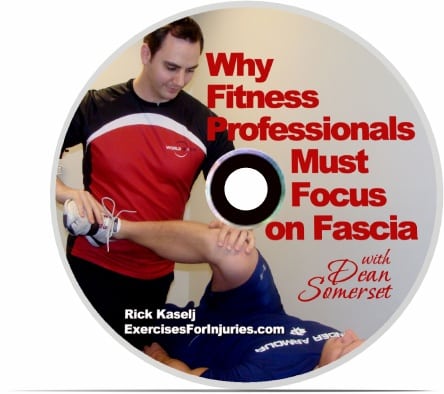
Fascia is a broad term describing the connective tissue surrounding and supporting our bodies. Fascia comprises two main tissue types, collagen, and elastin, found in all mammals, including humans. Collagen makes up most of the body’s connective tissue but is primarily responsible for maintaining the structure of organs such as the skin and blood vessels. Elastin is responsible for keeping organs like blood vessels flexible. Fascia also plays an essential role in regulating body movement and maintaining body temperature.
In addition to its structural function, fascia regulates movement and maintains healthy muscle tone. It provides a framework for muscles to move around and supports joint movement, allowing for a better range of motion and flexibility.
Another excellent interview for you today. It the importance to address fascia in an exercise program.
Here is an interview with Dean Somerset.
Take it away, Dean.
What is Fascia?
Fascia is a continuous web of connective tissue that connects muscles to organs connects muscles. It is constructed of collagen, a structural protein found in bone and teeth. It’s a durable, fibrous substance similar to paper in density. This tissue encapsulates connective tissues, such as nerves, blood vessels, and muscles, to form an interconnected network. We are held together and supported by this connective tissue, which is also very flexible and enables us to expand and constrict. Because these layers are discontinuous, muscles may move more freely when they slide across.
Benefits of Working With Fascia
According to the citation above, fascia is a connective tissue that supports and surrounds muscles, nerves, blood vessels, and other soft tissues. Working with fascia can help your clients improve posture, improve athletic performance, prevent injuries, and feel a better quality of life. Because of the state of fascia, postural awareness and function are linked. When tight and restricted, the body will compensate by adopting compensatory postures to pay for the lack of support in that area. Working with your fascia will help you recognize when your clients are doing the same thing. If the client has adhesions and muscle tension in his hips and pelvic areas, he will have difficulty rotating properly with his legs when playing golf or tennis. A proper assessment and treatment of tissue tightness and adhesions are critical to avoiding these issues.
Why so many people have fascia problems
Many individuals suffer from problems with their fascia, which can be too tight or too loose due to lifestyle factors. A person sitting for too long a time might get adhesions in their glutes and hips. Other factors that trigger fascia issues include poor posture, poor movement patterns, repetitive behavior, and injuries. Poor posture can cause the fascia to become shortened and restricted. It can become thick and tight due to repetitive activities such as lifting weights or typing on a computer. It can also become stale, tense, and sticky due to an injury. Manual therapy can alleviate these problems.
What you can do to help clients with fascial issues
If your clients have issues with their fascia, you can help them resolve them with soft tissue release (STR) techniques and targeted myofascial release (MFR) techniques. STR techniques include foam rolling, a massage roller or Barral’s table, self-myofascial release, and other similar techniques. MFR techniques are primarily manual therapies such as myofascial release (MFR), trigger point release (TPR), and others. Of course, if a client has a severe medical condition, you should refer him to a medical professional. But if the issue is purely soft tissue related, you can help your clients resolve their problems and lead healthier, happier lives.
Summary
Fascia, a connective tissue that connects muscles and organs, is composed of collagen, a protein found in bones and teeth. Because it is highly fibrous and densely packed, it consists of collagen. Because it gives structure and support to our movements, It is an essential part of our bodies. By working with fascia, you can help your clients improve their posture and athletic performance, prevent injuries and improve their quality of life. Soft tissue release techniques can also help your clients with adhesions and tightness.
Rick Kaselj, MS
Podcast: Play in new window | Download



